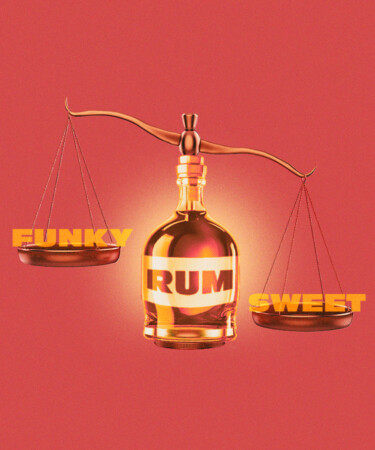The concept of hogo is admittedly hard to describe. And even when you figure out how, the funky, rum-exclusive flavor profile can sound more off-putting than appealing: Body odor, sweat, and wild game are all accurate notes. But when cultivated the right way, the aroma and taste of hogo can take a bottle of rum from run-of-the-mill to extraordinary.
The in-the-know term is derived from the old French phrase “haut gout,” or “high taste,” originally used to describe game meat, particularly that of birds left to hang for several days before consuming them. In the 1700s, however, English merchants made it part of the rum world vernacular to express a funky quality specific to raw sugar cane juice. Early on, hogo was identified as an “off” or undesirable characteristic when encountered in a bottle. In 1740, Charles Leslie wrote a review of a raw cane juice sample, describing it as “without any ill Taste or Hogo.” Forty-eight years later, James Newport of Philadelphia was making rum, bragging that his product was “very well-flavored, and free from hogo.”
As the 20th century rolled around, cleaner fermentation practices and column distillation weeded out hogo in many modern rums. But there were a few styles that still harnessed the hogo essence, such as rhum agricole, Cachaça, and many Jamaican rums. When the cocktail renaissance was underway at the turn of the 21st century, people started to long for hogo, wanting more complexity in their rums for cocktail making. Nowadays, more rum brands have made it a point — even a part of their advertising — to include hogo flavor in their rums.
Hogo is a balancing act: Too much, and the rum skews foul-smelling, just like too much truffle can overwhelm a plate of pasta. Not enough, and the rum will be lackluster — like sweet, one-note vodka or brandy. While there’s never been a thorough scientific breakdown of how distillers control hogo levels, Leslie’s notes still prove crucial in understanding the source of the pungent aroma. It turns out that hogo doesn’t come directly from the cane juice itself, but from the rum fermentation process. To get a solid explanation of how this works, we consulted rum experts like Jeff “Beachbum” Berry and Brian Miller, but all sources pointed to drinks historian Dave Wondrich and his breakdown of hogo in the “Oxford Companion to Spirits & Cocktails.”
“It’s only when alcohol is introduced through long fermentation in a bacteria-rich environment that sugarcane juice and its derivatives develop the esters that convey hogo, and only with distillation that they become concentrated enough to be truly aromatic,” Wondrich writes. Aging rum can eliminate some of these molecules, but if they are in high enough concentration, hogo-contributing elements will still be present regardless.
As for the bacteria-rich environment, many pot-still rums, particularly those from Jamaica, involve “dunder” and “muck” in their distillation process. Dunder is a viscous, tar-like blob made predominantly of distillation residue from previous fermentations, dead yeasts, bacteria, and sugar cane waste. It’s often kept in earthen, open-air “muck holes,” or “pits,” outside a distillery. Distillers will draw from the muck pit and add it to new fermentations, save the muck and dunder from that fermentation, and repeat the process. It’s kind of like a sour mash or a solera system with fermentation residue. Due to muck’s high fatty acid count, it hinders active yeasts during sugar cane or molasses fermentation, prolonging the process and leaving some raw sugar compounds in the resulting rum.
While most Caribbean rums ferment for roughly 24 hours, Hampden Estate — the producer of the famously hogo-rich Smith & Cross rum — lets fermentation run for two to three weeks, allowing all sorts of wild flavors to develop. Meanwhile, muck gets added to the ferment, drawing out more esters, the natural compounds produced during the fermentation process as acids react with alcohol. According to Wondrich, many factors influence what kinds of esters form, whether they are “base ingredients like grain, fruit, and molasses, fermentation temperature and length, yeast strain(s) used, or the surrounding climate.” A lot of hogo character stems from the rum’s ester-friendly fermentation process, in which acid-rich muck acts as a catalyst for more esters to develop. So, in addition to a lengthy fermentation, the muckier the muck, the more likely it is that hogo elements will be present.
Muck pits are believed to have originated in Jamaica, but hogo isn’t exclusive to Jamaican rums. As detailed above, it’s more of a terroir-driven flavor phenomenon. Depending on where the sugar cane or molasses are harvested as well as which wild yeasts are native to the distillery’s location, different esters and nuanced notes will show up in the rum. The hogo that comes in Smith & Cross rum is oozing with notes of overripe banana, baking spices, and cut grass with a light diesel undertone. Another Jamaican offering, Wray & Nephew Overproof white rum, has a hogo bouquet of grilled pineapple, clove, walnuts, and yellow cake. Rhum J.M. Agricole Blanc, distilled on the French island of Martinique, has hogo that draws from the island’s volcanic soil, which imparts minerality and a distinctly vegetal nose backed up by sweet notes of lime, pineapple, and honey.
Though hogo isn’t easy to pinpoint, once one becomes familiar with it, the flavor is unmistakable. Go to the local bottle shop and ask the staff for recommendations on funky Jamaican rums or rhum agricole, and they should steer you in the right direction. Or just buy a bottle of Smith & Cross, some Campari and sweet vermouth, and you’ll be on your way to a Kingston Negroni. However you decide to begin your journey, the world of hogo awaits.
